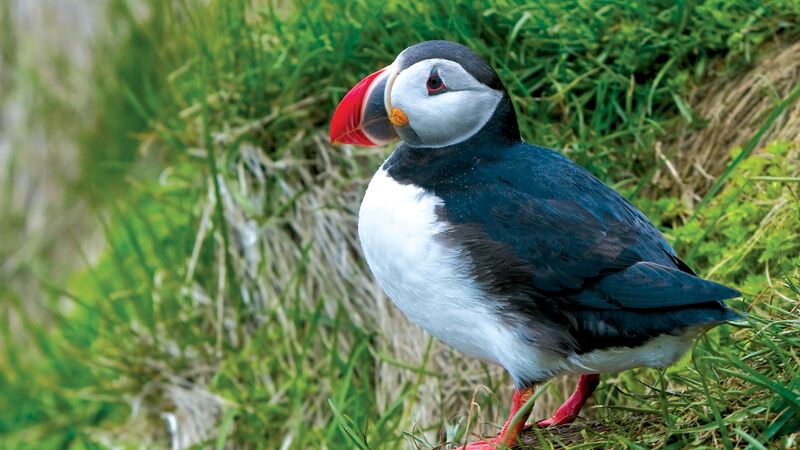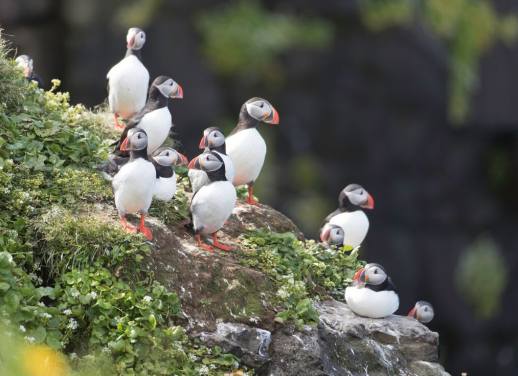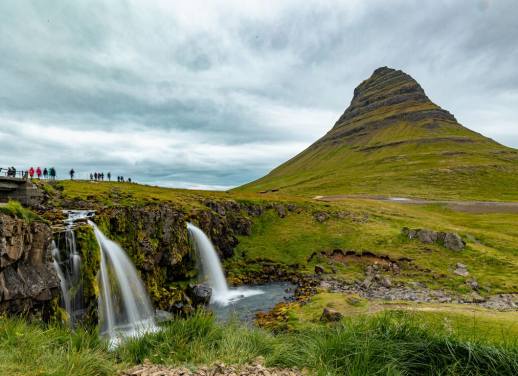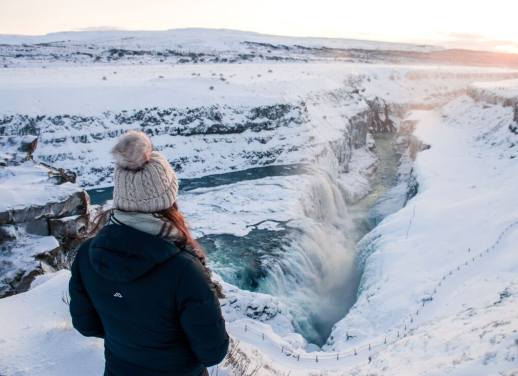This article first appeared on the Peregrine Wanderer and has been republished with permission.
The wind is howling as we step out of the minivan at the Latrabjarg Cliffs in Iceland. Our guide for day, a young woman who’s lived in the small town of Patreksfjordur since she was born, tells us to sit on the ground if the wind gets too much.
After walking for a few minutes directly into the wind, sitting down becomes tempting; it’s hard to stay upright, and I’m worried the next gust might blow me over the edge of the cliff (there’s no danger of this happening. My slight fear of heights has me stationed well away from the edge!). I wonder how the rest of my group – a cluster of brightly coloured puffer jackets making their way up a narrow path to a bluff – are faring.

My companions and I are travelling on a small group adventure around Iceland; it’s summer – early July – and the weather has not been our friend. We’ve experienced grey skies, driving rain, and strong gales (today really takes the cake), but no one comes to Iceland for the lure of perfect weather. It’s unpredictable, but we’re all as prepared as can be, rugged up in layers, longjohns and warm jackets.
EXPLORE ICELAND ON A SMALL GROUP ADVENTURE – SEE OUR RANGE OF TRIPS HERE
Today we’re exploring Iceland’s – and Europe’s – westernmost point. We spent some time wandering around the Garðar BA 64, a hulking Norwegian whaling vessel that was run aground on a tiny stretch of beach in the Skápadalur Valley in 1981. The sight of this imposing rusted iron ship on a black sand beach, with a backdrop of craggy moss-covered mountains, makes this spot a haven for photographers. After a brief stop at the sweeping Rauðasandur Beach, we pile back into the van to Latrabjarg.

Latrabjarg is the largest bird cliff in Iceland – 14 kilometres long and, at its highest point, 441 metres above sea level – and is considered by many to be the world’s most magnificent cliff-side nesting area. A wall of rock, peppered with patches of bright green grass and pink flowers, dropping vertically into the ocean. It’s dizzying. Hundreds of birds soar out of nooks in the cliffs, high up into the air, and then down into the Atlantic Ocean to scoop up fish. I’d seen flocks of birds before, but nothing quite like this.
SUBSCRIBE TO INTREPID’S NEWSLETTER FOR TRAVEL DEALS, STORIES, TIPS AND MORE
We’ve come at a good time. While today’s gales don’t really spell ‘summer’, June and July are the best months to see the huge variety of birds inhabiting the cliffs. Guillemots, razorbills, and the aggressive Arctic tern crowd the ledges of the cliffs; it’s estimated the bird population at Latrabjarg hits one million in early summer.

Most of us have come to see Iceland’s chubby avian superstar: the puffin. This is one of the best spots in the country to see the highly photogenic bird, and, after a few failed ‘is that one?’ almost-sightings, we spied a pair sitting just below the ground line of the cliff. Birdwatchers rushed over with cameras, some lay on the ground to get the best shot, some just looked on admiringly; one tourist stepped over the safety barrier to get a better angle, which was frowned upon by everyone nearby (the edges of the cliffs are soft and can give way at the slightest pressure, and the ocean is a long way down; the ‘perfect’ puffin shot is certainly not worth your life).
RELATED: 22 PHOTOS THAT WILL INSPIRE YOU TO BOOK A TRIP TO ICELAND ASAP
When photographing puffins, never use the flash setting on your camera or phone, as it can damage their eyes. The birds here, accustomed to the hordes of visitors that flock to the cliffs every year, are also exceptionally tame, but you must never try to touch them. They have a firm bite if you get too close.

They’re much smaller than I imagined, and far less graceful; they fly with a frenetic flapping of their wings, rather than the gentle soar I had expected. Their small wings actually enable them to ‘fly’ underwater, quickly scooping up a beak-full of fish before returning to the rook to their puffin partner. Like wolves, swans and penguins, puffins usually breed with the same mate each year. And the etymology of their name stems from the word ‘puffed’ or ‘swollen’; it reminds me of the travellers around me, zipped up in their puffy jackets (myself included).
After spending an hour of so at the cliffs, wandering up to the bluff, happily spotting more puffins, and trying to stay upright, our group returns to the warmth of the van. We unzip our jackets, remove scarves, blow into cupped hands to remove the icy chill from our fingers. We compare photos and chatter like excited school students returning from an excursion; “how many did you see? Did you see that pair at the top? I can’t believe there are so many!”. It’s been such a special day.
Even if you’re not a birdwatcher, a visit to Latrabjarg is highly recommended. It’s a beautiful spot to see a huge amount of birds in one of the most spectacular landscapes on earth.
Explore Iceland on a small group adventure with Intrepid now. Check out our range of trips here.
Hero image by Icer0ck via iStock. All other images by Damien Raggatt.




